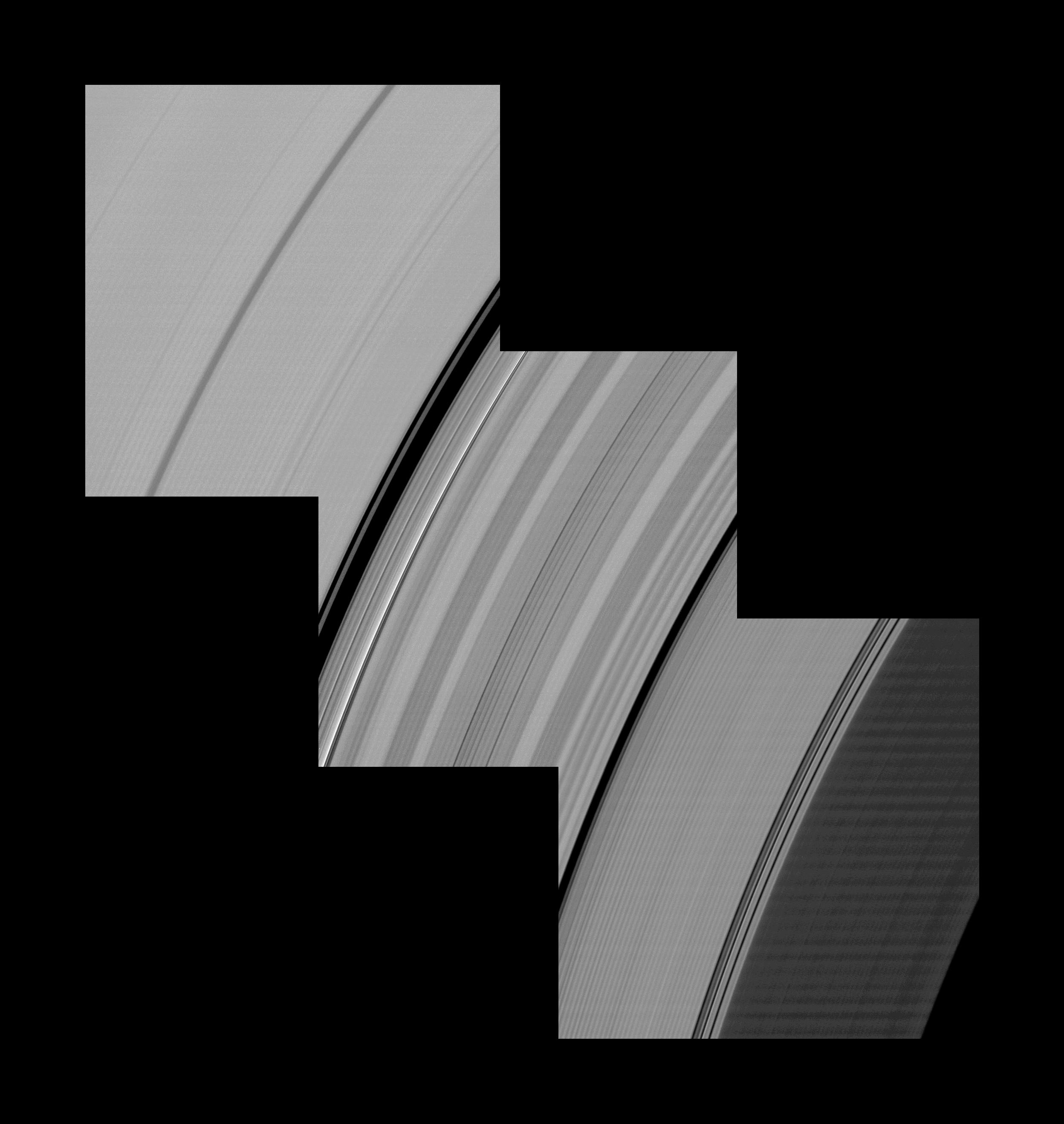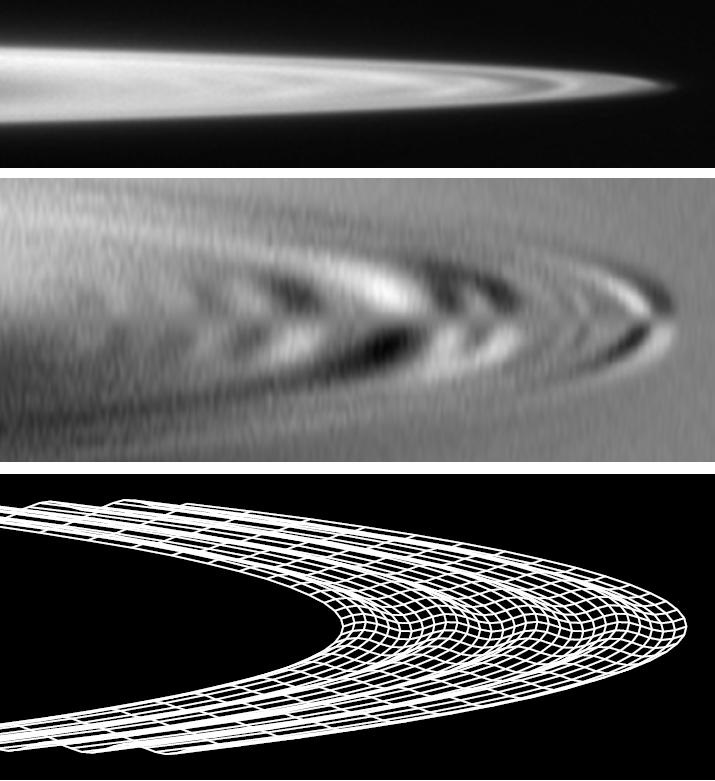NASA JPL-Caltech | Cassini Solstice Mission | 2011 Mar 31
Impacts Leave Marks on Rings of Saturn and JupiterLike forensic scientists examining fingerprints at a cosmic crime scene, scientists working with data from NASA’s Cassini, Galileo and New Horizons missions have traced telltale ripples in the rings of Saturn and Jupiter back to collisions with cometary fragments dating back more than 10 years ago.
The ripple-producing culprit, in the case of Jupiter, was comet Shoemaker-Levy 9, whose debris cloud hurtled through the thin Jupiter ring system during a kamikaze course into the planet in July 1994. Scientists attribute Saturn’s ripples to a similar object – likely another cloud of comet debris -- plunging through the inner rings in the second half of 1983. The findings are detailed in a pair of papers published online today in the journal Science.
“What’s cool is we’re finding evidence that a planet’s rings can be affected by specific, traceable events that happened in the last 30 years, rather than a hundred million years ago,” said Matthew Hedman, a Cassini imaging team associate, lead author of one of the papers, and a research associate at Cornell University, Ithaca, N.Y. “The solar system is a much more dynamic place than we gave it credit for.”
From Galileo’s visit to Jupiter, scientists have known since the late 1990s about patchy patterns in the Jovian ring. But the Galileo images were a little fuzzy, and scientists didn’t understand why such patterns would occur. The trail was cold until Cassini entered orbit around Saturn in 2004 and started sending back thousands of images. A 2007 paper by Hedman and colleagues first noted corrugations in Saturn’s innermost ring, dubbed the D ring.
A group including Hedman and Mark Showalter, a Cassini co-investigator based at the SETI Institute in Mountain View, Calif., then realized that the grooves in the D ring appeared to wind together more tightly over time. Playing the process backward, Hedman then demonstrated the pattern originated when something tilted the D ring off its axis by about 100 meters (300 feet) in late 1983. The scientists found the influence of Saturn’s gravity on the tilted area warped the ring into a tightening spiral.
Cassini imaging scientists got another clue when the sun shone directly along Saturn’s equator and lit the rings edge-on in August 2009. The unique lighting conditions highlighted ripples not previously seen in another part of the ring system. Whatever happened in 1983 was not a small, localized event; it was big. The collision had tilted a region more than 19,000 kilometers (12,000 miles) wide, covering part of the D ring and the next outermost ring, called the C ring. Unfortunately spacecraft were not visiting Saturn at that time, and the planet was on the far side of the sun, hidden from telescopes on or orbiting Earth, so whatever happened in 1983 passed unnoticed by astronomers.
Hedman and Showalter, the lead author on the second paper, began to wonder whether the long-forgotten pattern in Jupiter’s ring system might illuminate the mystery. Using Galileo images from 1996 and 2000, Showalter confirmed a similar winding spiral pattern. They applied the same math they had applied to Saturn – but now with Jupiter’s gravitational influence factored in. Unwinding the spiral pinpointed the date when Jupiter’s ring was tilted off its axis: between June and September 1994. Shoemaker-Levy plunged into the Jovian atmosphere during late July 1994. The estimated size of the nucleus was also consistent with the amount of material needed to disturb Jupiter’s ring.
The Galileo images also revealed a second spiral, which was calculated to have originated in 1990. Images taken by New Horizons in 2007, when the spacecraft flew by Jupiter on its way to Pluto, showed two newer ripple patterns, in addition to the fading echo of the Shoemaker-Levy impact.
“We now know that collisions into the rings are very common – a few times per decade for Jupiter and a few times per century for Saturn,” Showalter said. “Now scientists know that the rings record these impacts like grooves in a vinyl record, and we can play back their history later.”
The ripples also give scientists clues to the size of the clouds of cometary debris that hit the rings. In each of these cases, the nuclei of the comets – before they likely broke apart – were a few kilometers wide.
“Finding these fingerprints still in the rings is amazing and helps us better understand impact processes in our solar system,” said Linda Spilker, Cassini project scientist, based at NASA’s Jet Propulsion Laboratory, Pasadena, Calif. “Cassini’s long sojourn around Saturn has helped us tease out subtle clues that tell us about the history of our origins.”
Science Shots | Richard A. Kerr | 2011 Mar 31
Crashing comets make rings rippleWhizzing asteroids and comets have battered Earth and all the other solid bodies of our solar system over the eons, but the ethereal rings of the giant planets seemed immune. No longer. In two papers published online today in Science, researchers report that comet impacts in recent decades have left their mark on the rings of both Saturn and Jupiter. In August 2009, the orbiting Cassini spacecraft caught sight of 20-meter-high corrugations rippling across 1500 kilometers of Saturn's inner C ring (regular, narrow bright bands, above), which is only about 10 meters thick. The corrugations turn out to be one continuous wave spiraling outward like the groove in a vinyl LP record. And in 2007, the New Horizons spacecraft on its way to Pluto imaged two wave sets spiraling through each other in the faint, dusty ring of Jupiter. One Jovian wave appears to be still on the move 13 years after fragments from comet Shoemaker-Levy 9 hit the ring on their way to pummeling Jupiter in 1994. But for any impacting object to hit a tenuous ring hard enough to tilt it and set off such reverberations, both teams agree, it would first have to disintegrate into a cloud of fine debris that can hit a broad area of ring. That's just what Jupiter's gravity did to Shoemaker-Levy 9.
Nature News | Zeeya Merali | 2011 Mar 31
Saturn's Curiously Corrugated C Ring - MM Hedmann et alThe rings of Saturn and Jupiter contain ripples caused by comets that hit them decades ago. Monitoring how the rings wobble could reveal how common comet impacts are – and may also help astronomers map the planets' cores.
Matthew Hedman, an astronomer at Cornell University in Ithaca, New York, and his colleagues spotted the ripple in one of Saturn's rings in images taken by the Cassini spacecraft in 2009. Sunlight striking the rings edge-on revealed previously unseen bright and dark bands in the planet's C ring, which lies between about 74,600 and 92,000 kilometres from the planet's centre. "It's the same thing you see when sunlight races across a corrugated tin roof," says Hedman.
The undulations appear because particles in the rings are moving up and down, like people in a Mexican wave. The ripple formed when part of the ring was knocked out of kilter. As time passed, this tilt has become a progressively tighter spiral, meaning that the shorter the ripple's wavelength, the longer ago it was formed.
Using this relationship, Hedman and his colleagues calculated that the ripple began in 1983 and reasoned that it was caused by an unseen comet impact. As the comet broke up, they argue, its cloud of debris – with a total mass between 1011 and 1013 kilograms – bashed into the ring particles, making the ring tilt and wobble. Earlier Cassini images also showed signs of a ripple in the adjacent D Ring, probably caused during the same strike, Hedman says.
Strike two
Jupiter provides further evidence that comets make rings ripple. A team led by Mark Showalter at the SETI Institute in Mountain View, California, found two sets of ripples in images of Jupiter's rings taken by the Galileo spacecraft in 1996 and 2000 and by the New Horizons spacecraft in 2007.
The team calculated that debris from two comets had struck Jupiter's rings, the first between January and June 1990 and the second between July and October 1994. The latter date matches comet Shoemaker-Levy's plunge into Jupiter in July 1994.
"It just seemed like too good a match to be a coincidence," says Hedman, who worked on both sets of calculations. Both the Saturn and Jupiter findings appear online in Science today.
It's remarkable that ring systems can preserve a record of comet impacts stretching back decades, says Carl Murray, an astronomer at Queen Mary University of London, UK. "Essentially, they've developed an entirely new way of dating comet impacts," he says.
Hedman plans to examine future higher-resolution images of the rings still to come from Cassini and any future missions for signs of earlier collisions. "We'll poke around to see if we can get a picture of how frequent collision events are," he says.
Murray notes that monitoring the ripples will help astronomers discover more about the planets' innards - such as the size and shape of their cores, which may not be perfectly spherical. The ripples are slowly spiraling towards to the planets' centres at a rate controlled by gravity, which, in turn, depends on the planets' internal structure.
"It's tough for astronomers to find out much about that structure otherwise, but these particles could reveal all sorts of new information," Murray says.
- Science Express (online 2011 Mar 31) DOI: 10.1126/science.1202238
- Science Express (online 2011 Mar 31) DOI: 10.1126/science.1202241
Scientific American | John Matson | 2011 Mar 31
Jupiter and Saturn's rings show echoes of comet collisions
ars technica | John Timmer | 2011 Mar 31
New Studies: Planetary Rings Harbor Records of Past Smash-Ups
Universe Today | Anne Minard | 2011 Mar 31
Scarred by Comets: Rings of Saturn and Jupiter Show Signs of Impacts
Space.com | Science and Astronomy | Mike Wall | 2011 Mar 31
Comet collisions could cause rippled planet rings, research shows
Cornell University | Lauren Gold | 2011 Apr 01




